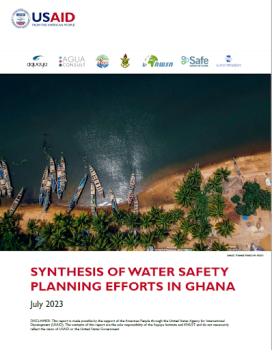EXECUTIVE SUMMARY
This report provides a synthesis of water safety plan (WSP) implementation efforts in Ghana. It highlights the implementation status, enabling environment, challenges, opportunities, and relevant recommendations for improvement.
BACKGROUND AND CONTEXT
Ghana exceeded the Millennium Development Goal (MDG) water coverage target to halve the proportion of the population without access to an improved water source by 2015. By 2008, rural and urban access levels to improved sources were 77% and 93%, respectively. The Joint Monitoring Programme (JMP) definition of “improved” drinking water sources includes “piped water on-premises” (i.e., a household water connection located inside the user’s dwelling, plot, or yard), public taps or standpipe, tube wells or boreholes, protected dug wells, protected springs, and rainwater collection.
Regardless of the water source, this definition does not specify whether the water is of good quality, and the incidence of water- and sanitation-related diseases remains high. Diarrheal disease mainly results from drinking fecally contaminated water, and is the third most reported illness by health centers across Ghana. Research suggests a majority of all illnesses in Ghana are linked to drinking unclean water and other exposures to fecal contamination. More than 6,600 diarrhea-related deaths are estimated each year, over half of which affect children under five.
This challenge is magnified in Northern Ghana, particularly in rural communities, where many people lack access to safe water. In the main northern region alone, more than 32% of the 2.5 million residents lack access to improved water sources.
Studies and national surveys in Ghana have found that many drinking water quality parameters do not conform to the national water quality standards. In 2015, Ghana developed a National Drinking Water Quality Management Framework (NDWQMF) based on the WSP approach of reducing contamination and other water supply risks. The Ghanaian NDWQMF promotes an understanding of the entire water supply system, including hazards that can compromise drinking water quality and the operational control needed to optimize drinking water quality and protect public health.
This report was produced by USAID’s Rural Evidence and Learning For Water (REAL-WATER) Activity.


